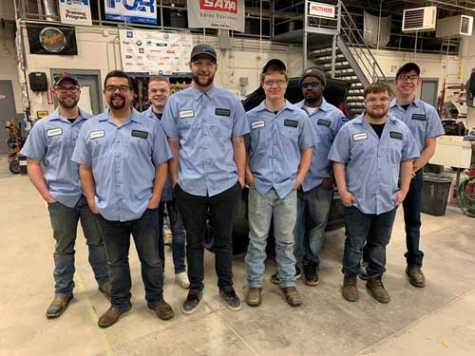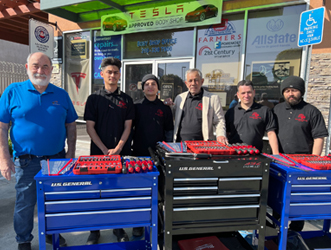Just over a decade ago, there were approximately 1,400 high school and college collision repair programs in the United States, according to Brandon Eckenrode, director of development for the Collision Repair Education Foundation (CREF).
The latest statistics show that number has dropped dramatically to roughly 1,000.
Eckenrode frequently receives calls from concerned technical instructors who tell him that if enrollment doesn’t increase, their school programs will most likely be shut down and students won’t have access to the training necessary to work in the collision repair industry.
As a result, CREF is taking steps to support these programs and ensure there will be enough students to help fill the overwhelming number of jobs currently available.
“There are more opportunities than people available to fill these positions,” said Eckenrode. “We’ve heard from some of the school instructors that without our help and the different donations we support, their programs would be closed.”
In some schools, instructors reportedly are only allocated $50 per student for the entire year.
“It’s difficult for instructors to graduate a highly trained, entry-level staff member when they are facing limited budgets,” said Eckenrode who has worked with CREF since 2009.
CREF’s roots date back to 1991 when the collision industry was also facing a critical shortage of qualified and well-trained entry-level employees and was initially focused on distributing I-CAR curricula to high school and college students. It was designed to teach the body shop skills required of entry-level employees.
In 2008, CREF became a traditional, 501c3 philanthropic organization, working with industry partners to support high school and college collision repair school programs, students and instructors across the country. The first year, the organization raised $300,000. Since then, that number has grown to $100 million.
More than 85 percent of what has been raised comes in the form of in-kind donations, including tools, equipment, supplies, paint, estimating software and safety glasses. Eckenrode said schools desperately need these items, especially when faced with increasingly limited and shrinking budgets.
Each year, interested schools complete a CREF survey to be eligible for monetary and in-kind donations. The survey asks details about their budget, enrollment and placement information so the organization can learn more about their situation and determine their needs. CREF then reaches out to a wide range of potential donors to fulfill the requests. Both traditional collision repair vendors and non-traditional businesses, such as flooring companies, have shown their support over the years.
Ninety cents of every dollar raised by CREF goes directly to the schools, students and instructors. CREF has been recognized by Charity Navigator as a four-star (out of four stars) charity due to its lean operational expenses and ensuring that as much as possible goes back to the schools.
Not only have these donations made a significant impact on existing school programs, but Eckenrode said they have also helped attract new students to the industry and put processes in place to employ the students after graduation.
One of the main ways Eckenrode said that CREF is making a difference is through its career fairs. Over the last few years, CREF began facilitating and organizing these events in major markets across the country to bring students and the industry together. Typically held in schools, neighboring high school and college students are invited to learn about the various career opportunities open to them. Initially, about 200--300 students attended each event. Over time, this number has grown to include about 400-plus students. In addition to collision repair students, participants also include those interested in auto service and automotive heavy-duty diesel, which Eckenrode said has been successful in giving hiring companies a larger pool of potential employees to choose from.
Those students who register for the career fairs at least 30 days prior to an event receive new Cintas technician shirts to wear. Eckenrode estimates they have distributed more than 75,000 of these shirts over the years.
The uniforms have made a positive impact on the program, according to Eckenrode, because the students look like industry professionals and are treated with a new level of respect by their peers and school staff.
“What we have heard from a lot of the instructors is those students attending these events were great motivators to make sure they stayed within the program,” said Eckenrode. “Instead of an instructor standing in front of class and saying there is an industry ready for you and wanting to employ you, students have the opportunity to meet these businesses first-hand and learn about the opportunities available.”
Eckenrode said the goal is to continue increasing the number of career fairs held each year and track how effective they are.
“Because these career fairs are open to not only seniors, but also students just starting out their technical careers, it’s not always easy to track the successes because students might attend the events, but not be immediately looking for work ,” said Eckenrode. “However, by attending the events, they see what is waiting for them and stay within the programs and are able to network with the participating companies.”
A recent example came as a result of an event held in Tampa earlier this year. The Ferman Auto Group, one of the largest dealership groups in the U.S, hired eight students following one of CREF’s events.
Eckenrode said the CREF team and supporters are continually working to enhance the career fairs. They recently started capturing students’ resumes and contact information electronically so companies that participate have access to the information and can follow up about job opportunities.
Another recent addition is the interview sessions CREF has put into place during some of the career fairs. In some cases, students have the opportunity to participate in a mock interview session while other times, one-on-one interviews are arranged with hiring companies.
To help increase the number of events per year, CREF is working closely with I-CAR committees to create their own local career events. The goal is to have one in every major market. The next Solving the Tech Shortage column will feature information about I-CAR initiatives, including the local career fairs planned by I-CAR committees.
Part of the expansion plans also includes holding career fairs in different venues, such as the Denver Auto Show, which was held in March. Through the partnership with the Colorado Auto Dealers Association, CREF had the opportunity to talk to parents and students who otherwise might not have been familiar with the industry and then showcase the different career paths available.
Eckenrode advises shop owners and managers unsure about how to hire graduating students to find out about their local school programs if they haven’t already done so. For those in the industry who have hired technical students in the past and felt they weren’t prepared, he encourages potential employers to be persistent and work through the issues to help improve the programs. By putting in the time and showing their support, he said students will likely be more qualified when they graduate and better prepared for the future.
“It’s a matter of getting these businesses in front of instructors and schools and involved in advisory boards as well as getting in front of the administrations,” he said. “What we’ve heard, time and time again, is that if the administration sees companies interested in hiring these students, there’s a better chance that they will want to keep these programs running.”
In addition to attending a career fair, especially if one is not yet available in the area of the country where a body shop is located, Eckenrode said there are several ways to get involved and make a difference. For example, some collision repair facilities have sponsored new uniforms for students while many others have donated supplies, tools and equipment.
“There are things [body shops] can do, working together with us, where they can help encourage students,” he said. “We’re all in this together, so having a collective force at the local level is where we think we are going to make the biggest impact.”
The spring CREF career fairs have wrapped up; however, an initial list of markets where the events will be held this fall include (more expected to be added):
St. Louis, MO (9/27)
Gateway Motorsports Park - 700 Raceway Blvd - Madison, IL
Detroit, MI (week of 10/8)
Oakland Community College -1200 Mead Rd - Rochester, MI
Dallas, TX (10/17)
Mercedes-Benz Learning & Performance Center- Grapevine, TX
Northern California (10/22)
Contra Costa College - 2600 Mission Bell Dr. - San Pablo, CA
Southern California (10/24)
Cerritos Community College - 11110 Alondra Blvd - Norwalk, CA
Robbinsville, NJ (11/21)
Mercedes-Benz Learning & Performance Center - Robbinsville, NJ
Houston, TX (TBD)
Chicago, IL (TBD)
Northern Virginia (TBD)
Miami, FL (TBD)
To get involved with one of these events, help organize your own career fair locally, and/or be connected with your local collision school programs, you can reach Brandon Eckenrode at Brandon.Eckenrode@ed-foundation.org or 312-231-0258.















Stacey Phillips Ronak